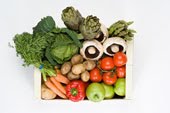The techniques employed in French cuisine are many and varied. First of all a thorough knowledge and understanding of all the ingredients used is essential. Most of the principles of this type of cuisine are generic and can be found in many kinds of cookery but the most important element to remember is that French cookery does not rely on convenience methods however labour saving they may be.
The art of sauteing is one technique that is widely used. Sauteing is the method used to fry onions and garlic in olive oil at a high temperature. Some culinary terms in French cuisine are necessary to have some knowledge of before attempting a recipe. These three essential terms refer to basic cuts:
Brunoise - This is a square cut, each side being 8 inches.
Dice - a quarter of an inch cut
Chop - a half inch cut
A professional French chef will know the exact dimensions of these cuts and anyone who is trying to achieve an authentic French dish should be thoroughly acquainted with these terms.
It goes without saying that to achieve the correct results you should consistently use the basic French cooking techniques. French cooking relies heavily on only the freshest ingredients and if you can follow this example by only purchasing your produce from reputable greengrocers and markets. If dedicated to this aim find out when markets receive their deliveries and when these are available for sale. In this way you will have the chance to select the freshest choice of vegetables. In the spirit of French cuisine it is always good to be imaginative and make alterations to your recipe where needed.
One element of French cooking is patience. The techniques used in French cooking to produce wonderful sauces are painstaking. To prepare the stock for any sauce most recipes call for unsalted butter or occasionally clarified butter. Unsalted butter is used in preference to salted butter in the preparation of any stock as it doesn't hamper the flavour of the the food it will accompany. In the same vein no other seasoning such as salt or paper should be used in the preparation of the stock. To retain the stock for future use it can be frozen and kept for no longer than three months for the best results.
Prepare labels to identify your stocks whilst in storage. When ready to use for the preparation of the sauce you wish to make use a copper bottom or heavy duty pan.
It is customary for sauces that are made from butter and clarified butter stocks are made prior to serving the dish that the sauce will accompany. There are different temperatures at which certain sauces should be served. White butter sauces should be served at a warm temperature and kept that way. Butter sauces should be served hot.
Some sauces require a thickening agent. However, in the case of Beurre Marie, the butter can be used straight from the refrigerator and mixed with flour. For more information about French cooking techniques there is a wealth of information on the internet and many cookbooks are dedicated to this subject.
These are just a few tops that may inspire you to learn more about French cooking techniques and give you an insight into French cuisine.
Abhishek is really passionate about Cooking and he has got some great Cooking Secrets. up his sleeves! Download his FREE 88 Pages Ebook, "Cooking Mastery!" from his website http://www.Cooking-Guru.com/770/index.htm. Only limited Free Copies available.
Article Source: http://EzineArticles.com/?expert=Abhishek_Agarwal
Subscribe to:
Post Comments (Atom)



No comments:
Post a Comment